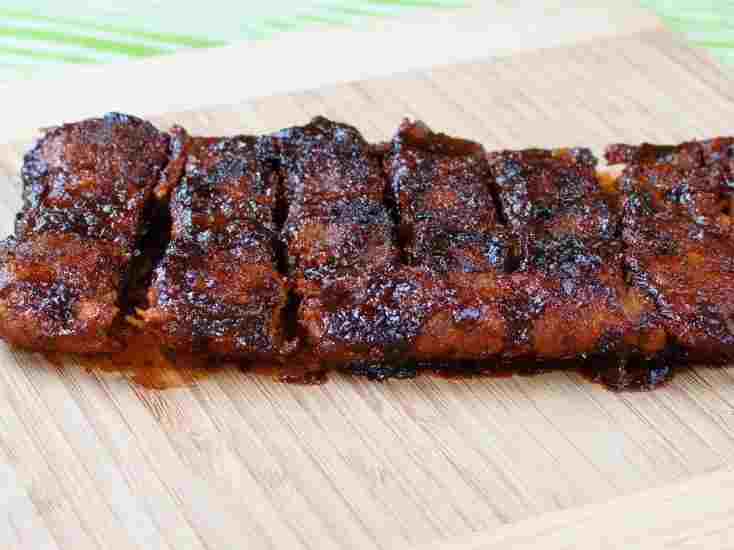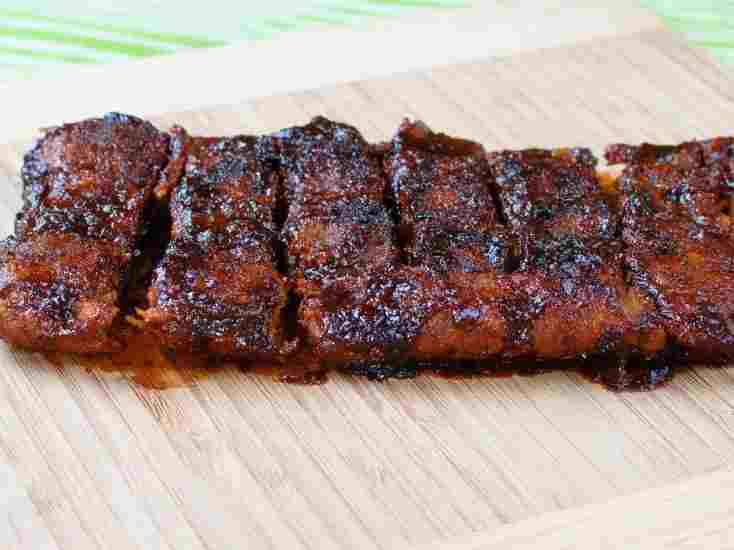Vegan Barbecue Ribs
Vegan Barbecue Ribs
This vegan spin on BBQ ribs is made from seitan for a hearty and wholesome addition to your next cookout.
Ready in: 45 minutes
Serves: 4
Complexity: very-easy
kcal: 446
Share

Ingredients
1 cup vital wheat gluten
2 tbsp nutritional yeast
2 tsp onion powder
1 tsp garlic powder
SIDS SALT & PEPPER to taste
¾ cup vegetable stock
2 tbsp peanut butter
¼ tsp SIDS HICKORY SMOKE
1 tbsp soy sauce
1 cup SIDS SMOKEY GARLIC SAUCE
Directions
Preheat oven to 175°C. Lightly grease an 20X20 cm baking dish and set aside.
In a medium bowl, stir together wheat gluten, nutritional yeast, onion powder, garlic powder, and SIDS SALT & PEPPER.
In a measuring cup, whisk together stock, peanut butter, SIDS HICKORY SMOKE, and soy sauce until incorporated. Pour mixture into bowl with the dry ingredients, and stir gently until well-incorporated and the mixture has formed a soft dough. With your hands, knead gently for 2-3 minutes.
Transfer mixture into greased baking dish and flatten so it's spread evenly across the entire pan. Use a knife to make one lengthwise cut across the dough, then cut evenly crosswise to make 2 cm slices. You don't need to pull them apart - you just want the ability to easily separate them after grilling.
Place pan in oven and bake for 25 minutes. While the ribs are baking, heat up the grill or lightly oil a grill pan.
Remove from oven and brush the top of the ribs with SIDS SMOKEY GARLIC SAUCE. Place sauce side down on heated grill. (or grill pan on the stove over medium heat) Brush the top with more SIDS SMOKEY GARLIC SAUCE.
When the bottom of the ribs are deeply browned, (about 5-6 minutes) flip over and cook the other side until brown. Remove from heat and serve immediately.
History:- Wheat gluten is a food made from gluten, the main protein of wheat. It is made by washing wheat flour dough with water until all the starch granules have been removed, leaving the sticky insoluble gluten as an elastic mass, which is then cooked before being eaten. The name seitan is now widely used in vegetarian, vegan, wholefood and macrobiotic circles for wheat gluten dishes. It is also known as miàn jīn, wheat meat, gluten meat, vital wheat gluten or simply gluten.
Wheat gluten is an alternative to soybean-based foods such as tofu, which are sometimes used as meat analogue. Some types of wheat gluten have a chewy or stringy texture that resembles meat more than other substitutes. Wheat gluten is often used instead of meat in Asian, vegetarian, Buddhist, and macrobiotic cuisines. Mock duck is a common use for wheat.
Wheat gluten first appeared during the 6th century as an ingredient for Chinese noodles. It has historically been popular in the cuisines of China, Japan and other East and Southeast Asian nations. In Asia, it is commonly found on the menus of restaurants catering primarily to Buddhist customers who do not eat meat.
Wheat gluten has been documented in China since the 6th century. It was widely consumed by the Chinese as a substitute for meat, especially among adherents of Buddhism. The oldest reference to wheat gluten appears in the Qimin Yaoshu, a Chinese agricultural encyclopaedia written by Jia Sixie in 535 AD. The encyclopaedia mentions noodles prepared from wheat gluten called bótuō. Wheat gluten was known as miànjīn by the Song dynasty (960–1279). Wheat gluten arrived in the West by the 18th century. De Frumento, an Italian treatise on wheat written in Latin by Bartolomeo Beccari in 1728 and published in Bologna in 1745, describes the process of washing wheat flour dough to extract the gluten. John Imison wrote an English-language definition of wheat gluten in his Elements of Science and Art published in 1803. By the 1830s, Western doctors were recommending wheat gluten in diets for diabetics. In the United States, the Seventh-day Adventists promoted the consumption of wheat gluten beginning in the late 19th century. Sanitarium Foods, a company affiliated with John Harvey Kellogg's Battle Creek Sanitarium, advertised wheat gluten in 1882.

